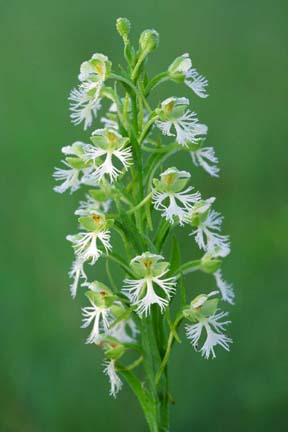Eastern prairie fringed orchid facts for kids
Quick facts for kids Eastern prairie fringed orchid |
|
|---|---|
 |
|
| Conservation status | |
| Scientific classification | |
| Genus: |
Platanthera
|
| Species: |
leucophaea
|
| Synonyms | |
|
|
The Platanthera leucophaea, also known as the eastern prairie fringed orchid, is a special and rare type of orchid. It grows naturally in North America. This beautiful flower is officially listed as a threatened species in the United States. This means it needs protection to survive.
Contents
Where the Eastern Prairie Fringed Orchid Lives
The eastern prairie fringed orchid likes to live in wet places. You can find it in moist prairie lands, wet meadows, and special boggy areas called fens. It grows best where there are not too many trees or bushes.
Historic Locations
In the past, this orchid was mostly found around the Great Lakes Region. Some smaller groups were also seen in places like Maine, Virginia, Iowa, and Missouri. There was even a record of it in Oklahoma a long time ago. However, it has not been seen in Oklahoma for about 150 years.
Why It's Disappearing
The main reason this orchid is becoming rare is because it is losing its home. People have used its habitat for farming or let animals graze too much. Also, fires used to help the prairie stay open, but now they are often stopped. This allows more trees and bushes to grow, which the orchid does not like.
What the Eastern Prairie Fringed Orchid Looks Like
The eastern prairie fringed orchid grows from a thick root called a tuber. The plant can grow quite tall, up to three feet (about 91 centimeters). Its leaves are long and thin, like blades of grass.
Its Flowers
This orchid has a large, showy cluster of flowers. It can have as many as 40 white flowers on one plant. These flowers are smaller than those of its cousin, the western prairie fringed orchid. They are less than one inch (2.5 centimeters) long. The petals are more oval, and the part that holds nectar is shorter.
Life Cycle and Pollination
The eastern prairie fringed orchid is a perennial plant. This means it lives for many years. Its special root helps it survive fires that might sweep across the prairie. In fact, fires and rain actually help the plant grow and bloom.
The plant usually starts to appear in May. Its flowers begin to open by late June. Large sphinx moths help pollinate the flowers at night. These moths are drawn to the orchid's sweet smell. They have long tongues, called proboscises, that can reach the nectar deep inside the flower. Other insects might be attracted but cannot reach the nectar because of the flower's unique shape.
See also
 In Spanish: Platanthera leucophaea para niños
In Spanish: Platanthera leucophaea para niños


